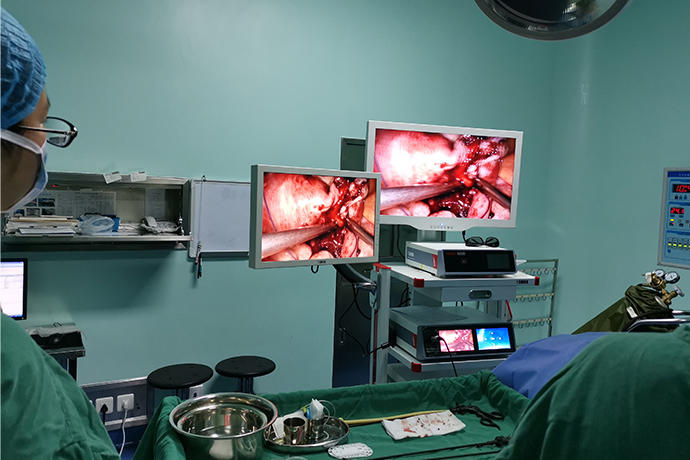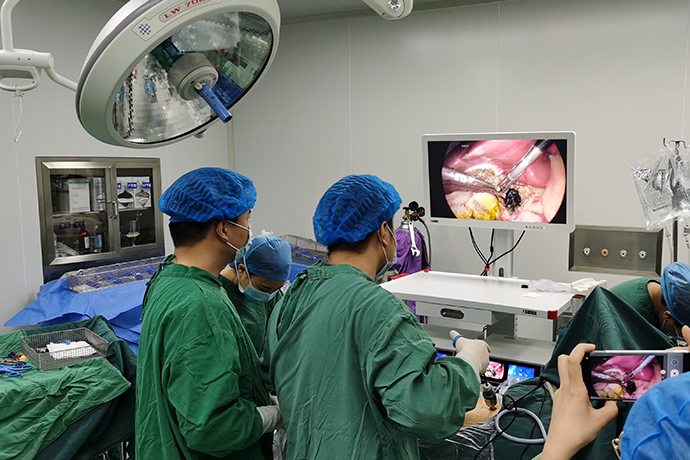[Gynecological Laparoscopy] 4K Laparoscopic Ovarian Chocolate Cyst Surgery
Release time: 17 Oct 2023 Author:Shrek
Bitter "chocolate"---ovarian chocolate cyst
Some people are full of questions when they hear the name "ovarian chocolate cyst". They have a cyst on a perfectly good ovary, and it's chocolate! what is happening! Don’t worry, let’s take you to learn more about it!

1. What is ovarian chocolate cyst?
Ovarian chocolate cyst, also known as ovarian endometriosis cyst (Varian endometrial cyst, OEC), is a special type of endometriosis and the most common one. It refers to the appearance of endometrial tissue with growth function in In estrogen-dependent diseases of the ovary, when the early lesions are very small, they are located in the superficial cortex of the ovary. As the lesions progress, the ectopic endometrium will invade the ovarian cortex, grow within the cortex, and repeat Periodic bleeding forms one or more cystic structures called ovarian endometriosis cysts. The fluid contained in these cysts is some old blood, and the color is dark red, like chocolate sauce, so they are also called ovarian chocolate cysts.
2. What age group is most susceptible?
Most patients develop the disease around the ages of 25 to 45. Women of childbearing age are the most susceptible period for endometriosis cysts, and they are more likely to occur in women with late childbearing, less childbearing, and infertile women.
3. What caused it?
First of all, iatrogenic dissemination is an important reason for the increased incidence of endometriosis. Cesarean section, induced abortion, hysteroscopy and abdominal surgery, etc., bring the endometrium to the pelvic cavity for ectopic implantation, causing ectopic implantation in the pelvis. Occurrence of chocolate cysts. Secondly, increased estrogen levels in the body are also one of the factors that induce cystitis. Some studies suggest that patients with autoimmune diseases may also contribute to the development of cysts.
Many times, chocolate cysts have no symptoms and are only discovered during a physical examination. When these clinical symptoms continue to appear, you must pay attention!
1. Pelvic pain: 70% to 80% of patients have varying degrees of pelvic pain, including dysmenorrhea, acute abdomen, dyspareunia, anal pain, etc. The degree of pain is not entirely proportional to the severity of the lesion. If the cyst ruptures, it can cause sudden severe pain in the lower abdomen accompanied by nausea, vomiting and other acute abdominal symptoms.
2. Abnormal menstruation: Patients may experience abnormal menstruation such as prolonged menstruation and irregular bleeding.
3. Infertility: Ovarian cysts can cause secondary infertility in women, such as decreased ovarian reserve function, changes in pelvic structure, and pelvic or fallopian tube adhesions.
So where should treatment go from here?
It is mainly divided into two types: drug and surgical treatment. Commonly used drugs include oral contraceptives, progesterone drugs, gonadotropin-releasing hormone agonists, etc.; surgical treatment is suitable for cases where symptoms are not relieved after drug treatment and the diameter of ovarian cysts is >5-6 Centimeters, the specific surgical method is selected based on whether the patient has fertility requirements. If the patient has fertility requirements, the surgery only removes the lesions and retains the uterus and ovaries, but the postoperative recurrence rate is about 40%. Pregnancy as soon as possible after surgery or drug-assisted treatment can help. to reduce the recurrence rate.
4K Laparoscopic Ovarian Chocolate Cyst Surgery
Laparoscopic multi-port or single-port operation is usually used to perform cyst removal. During the operation, care should be taken to protect the ovarian tissue. For older patients who do not have fertility requirements, one side of the appendage is removed.
During cyst resection, use an electric knife or scissors to make a 2cm opening in the cyst wall, then suck out the chocolate-like tissue, peel off the cyst wall, and finally flush the remaining ovarian tissue with normal saline. During the drainage operation, use an electric knife or scissors to make a 1cm opening in the cyst wall, then suck out the chocolate-like tissue, and then flush the cyst cavity with normal saline until the chocolate-like tissue is flushed clean. Instead of using the instant gauze group, use electrosurgery to stop bleeding. Use the instant gauze group. Divide the instant gauze into 4 equal pieces. According to the size of the chocolate cyst, stuff 4-8 pieces of gauze into the cyst cavity (DS group) or the remaining ovarian tissue (CS group), and then use 10ml of normal saline. Rinse the gauze. If the edge of the ovary is not continuous, use No. 4 sutures to perform 1-3 interrupted sutures. All patients were followed up every 3 months for a total of 2 years. During the postoperative follow-up period, no hormonal treatment was given. The primary outcome was ipsilateral chocolate cyst recurrence (defined as an ovarian cyst with characteristics of a chocolate cyst on ultrasound, ≥1 cm). Secondary outcomes were ovarian reserve (AMH and day 2 AFC).
1. Obtain the bladder lithotomy position
2. Position and puncture
Routinely open three holes, take the umbilical hole and insert the laparoscope; then perform the second and third punctures at the right McBurney's point and the corresponding points on the left
3. Exploring the pelvic cavity, separating adhesions, and restoring normal pelvic anatomy
Chocolate cysts are often accompanied by varying degrees of pelvic adhesions. In severe cases, the boundaries between the fallopian tube, ovary, and uterus are unclear. Adhesions should be freed as much as possible, separated from the normal tissue space, and the anatomy restored. Aspirate the chocolate-like liquid in the cyst, rinse the inner wall of the cyst, and then peel off the cyst wall.
4. Exfoliation of Ovarian Cysts
Chocolate cysts often rupture when adhesions are separated. Use curved forceps to grasp the cyst wall and ovarian surface serosa along the rupture opening, pull in the opposite direction, and mechanically peel off the cyst wall. If the ovarian surface does not rupture, electrocoagulate the ovarian surface to remove the cyst wall. The normal ovarian tissue is separated, the accumulated blood is aspirated with a flushing aspirator, and then peeled off
5. Suture the ovaries
Internal purse-string suture or continuous mattress locking suture can be used to form a normal ovary or leave the wound surface. If there is active bleeding on the wound surface, electrocoagulation can be performed.
6. Remove the cyst wall
If the peel is intact and unbroken, use a specimen bag to remove it; if the cyst is ruptured, use scoop forceps to remove it.
7. Rinse the pelvic cavity
If the cyst ruptures and the blood in the cyst contaminates the pelvic and abdominal cavity, flush it with a large amount of normal saline after surgery.
Laparoscopic surgery technology has obvious advantages and is currently an effective method to treat ovarian cysts. The use of 4K laparoscopic system can observe the diseased parts ultra-clearly and treat cysts and diseased parts. It not only makes up for the shortcomings of traditional methods, but also is suitable for those who are skilled in surgery. The doctor's operation time is short, and the ovarian tissue can be preserved as intact as possible, protecting the patient's fertility and helping the patient solve the problem. At the same time, minimally invasive surgery has the advantages of light damage, small wounds, quick recovery, no need for sutures, no need to remove stitches, and no scars. It is very suitable for the beauty needs of modern women, especially young women.

- Recommended news
- 【General Surgery Laparoscopy】Cholecystectomy
- Surgery Steps of Hysteroscopy for Intrauterine Adhesion
- [Gynecological Hysteroscopy] Techniques for Preventing and Treating Complications of Hysteroscopic Surgery
- [Gynecological Hysteroscopy] Hysteroscopic Adhesiolysis
- [Gynecological Hysteroscopy] IUD Removal under Hysteroscopy